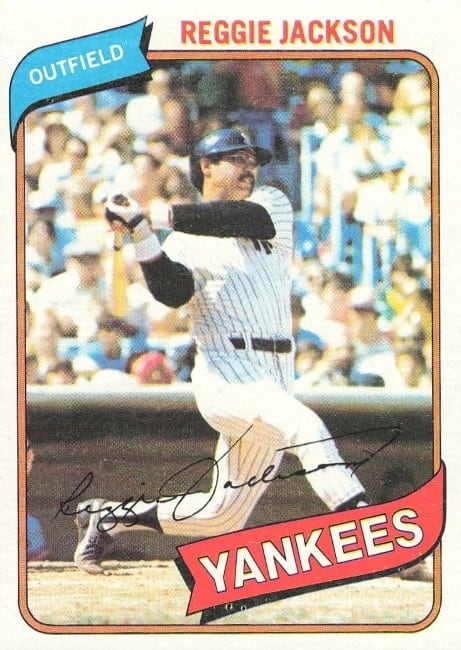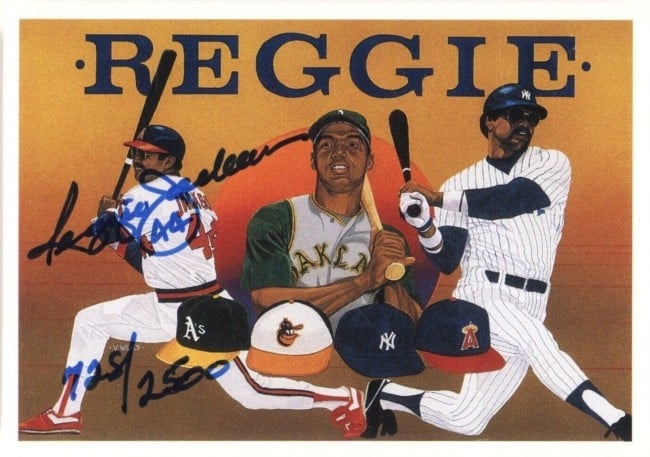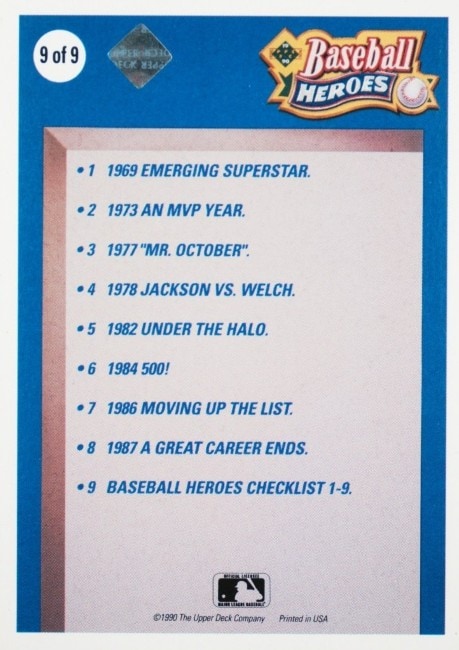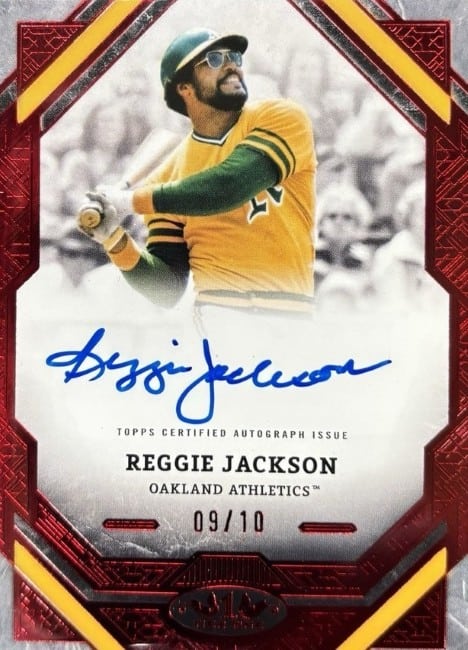The baseball card industry witnessed a seismic shift in 1990 when Upper Deck launched the “Find the Reggie” campaign. This promotional effort introduced collectors to the first major autographed chase card randomly inserted into packs, fundamentally transforming how manufacturers approached premium content and how collectors pursued rare cards. The campaign centered on a signed and serially numbered Reggie Jackson card that became an instant holy grail for hobbyists.
Upper Deck had already revolutionized the industry with its premium 1989 baseball debut, which featured superior card stock, full-bleed photography, and anti-counterfeit holograms. The company followed this success with an innovation that would prove even more influential. By inserting 2,500 autographed and numbered Reggie Jackson cards into their 1990 high series packs, Upper Deck created a template that modern manufacturers still follow today. The scarcity, combined with Jackson’s legendary status and the thrill of the hunt, generated unprecedented excitement among collectors.
The campaign’s impact extended far beyond 1990. It established the chase card concept as a cornerstone of the hobby, influenced pricing structures throughout the secondary market, and demonstrated that manufactured scarcity could drive sales even during an era of massive overproduction. Understanding the 1990 Upper Deck Reggie Jackson Heroes card requires examining not only the card itself but also the player’s legacy, the clever marketing behind the promotion, and the lasting effects on modern collecting culture.
The Legend of Mr. October

Reggie Jackson earned his place among baseball’s elite through a combination of prodigious power, clutch performance, and unshakeable confidence. Over his 21-year career, Jackson hit 563 home runs and compiled a .262 batting average while playing for the Kansas City/Oakland Athletics, Baltimore Orioles, New York Yankees, and California Angels. His regular season numbers tell only part of his story.
Postseason Dominance
Jackson’s postseason heroics cemented his legendary status and earned him the nickname “Mr. October.” He won five World Series championships – three consecutive titles with Oakland from 1972-1974, and back-to-back championships with the Yankees in 1977 and 1978. The 1977 World Series Game 6 performance remains one of the most iconic moments in baseball history. Jackson hit three home runs on three consecutive pitches against the Los Angeles Dodgers, clinching the championship for New York. Each home run traveled progressively farther, with the final blast reaching the center field black at Yankee Stadium.
Jackson’s World Series statistics underscore his clutch abilities. He batted .357 in Fall Classic games with 10 home runs, earning World Series MVP honors in both 1973 and 1977. His flair for the dramatic, combined with his outspoken personality, made him one of baseball’s most recognizable figures during the 1970s and early 1980s. When he famously declared, “I didn’t come to New York to be a star, I brought my star with me,” Jackson demonstrated the confidence that defined his career. The Baseball Hall of Fame inducted Jackson in 1993, recognizing both his statistical achievements and his impact on the game.
1990 Upper Deck Heroes Insert Set

Upper Deck’s 1990 Baseball Heroes series featured nine cards showcasing different moments from Reggie Jackson’s illustrious career. Artist Vernon Wells created distinctive illustrations for each card, giving the set a unique aesthetic that differentiated it from standard photography-based cards. Collectors could find these insert cards randomly distributed throughout high series packs, with each card featuring a facsimile signature.
The ninth card in the set served as a checklist for the entire Heroes series. Upper Deck selected 2,500 copies of this checklist card for Jackson to personally autograph and hand-number. Each signed card received a unique serial number from 1/2500 through 2500/2500, making every card individually identifiable. Jackson’s bold signature appeared prominently on the front of the card, accompanied by his hand-written serial number.
Anti-Counterfeiting Measures
The authentication features distinguished the autographed cards from their non-autographed counterparts. Most notably, the diamond-shaped hologram on the back of autographed cards contrasted with the circular hologram found on regular Heroes inserts. This deliberate differentiation allowed collectors to immediately verify authenticity without specialized equipment or expert examination. Upper Deck had learned from its 1989 debut that anti-counterfeiting measures mattered to collectors.
The variation within the autographed print run adds another layer of intrigue. Jackson inscribed “Mr. October” on cards with serial numbers ending in 00, creating 25 extra-special variations among the 2,500 signed cards. These inscribed versions command significant premiums in today’s market. This is similar to the 1994 Upper Deck that is frequently forged – certain copies were signed by Ken Griffey Jr., Mickey Mantle or both. Fraudsters buy the less valuable single-signed cards and add the additional autograph themselves.
“Find the Reggie” Campaign Launch
Upper Deck’s marketing team understood that education and excitement would drive the campaign’s success. They inserted special header cards into packs that explained the Heroes series and the autographed chase. The header card featured the Baseball Heroes logo on the front, while the reverse provided crucial information about the signed cards and their distinguishing characteristics, including the diamond-shaped hologram detail.
The campaign name – “Find the Reggie” – perfectly captured the treasure hunt mentality that Upper Deck wanted to cultivate. This simple phrase appeared in advertisements, on retail displays, and in hobby publications throughout 1990. The company deliberately chose not to reveal exact odds or insertion rates initially, allowing mystery and speculation to build organic buzz among collectors.
Timing & Market Conditions
Upper Deck’s timing proved impeccable. The late 1980s and early 1990s represented the peak of the baseball card boom, with millions of Americans actively collecting cards. Card shops proliferated across the country, card shows drew massive crowds, and new collectors entered the hobby daily. The company launched the campaign when maximum attention and purchasing power intersected, ensuring widespread awareness and robust sales.
The “Find the Reggie” promotion represented a calculated risk for Upper Deck. Convincing Reggie Jackson to sign 2,500 cards required significant negotiation and likely substantial compensation. The company also needed to develop secure processes for card distribution, hologram application, and quality control. However, Upper Deck recognized that establishing the chase card concept could provide competitive advantages that justified the investment.
Collector Response & Market Frenzy
Immediate Enthusiasm and Purchasing Patterns
The baseball card community responded to the “Find the Reggie” campaign with unprecedented enthusiasm. Collectors who had grown accustomed to complete sets and predictable pulls suddenly faced genuine scarcity and the possibility of striking gold with every pack they opened. This shift in collecting psychology generated intense demand for 1990 Upper Deck high series products.
Card shops struggled to keep high series boxes in stock as collectors bought cases hoping to find a signed Jackson card. The secondary market for sealed product remained robust for months after the initial release. Collectors who pulled autographed cards faced difficult decisions about whether to sell immediately, hold for long-term appreciation, or keep as prized personal possessions.
Early Market Values & Trading Activity

The autographed cards commanded strong prices from the moment they entered the market. Early sales typically ranged from $300 to $500 for standard numbered examples, representing significant value compared to most contemporary baseball cards. The “Mr. October” inscribed variations brought even higher premiums when collectors recognized their scarcity.
The campaign also generated extensive coverage in hobby publications. Beckett Baseball Card Monthly, Sports Collectors Digest, and other magazines featured articles about the Heroes series, pull rates, and market values. This media attention expanded awareness beyond traditional collector circles and attracted new participants to the hobby. The excitement surrounding the autographed Jackson cards demonstrated that manufactured scarcity could coexist with mass production and still generate genuine enthusiasm.
Paradox of Scarcity (In an Era of Overproduction)
Understanding why the 1990 Upper Deck Reggie Jackson autograph remained difficult to find requires examining the broader context of late 1980s and early 1990s production volumes. Card manufacturers printed baseball cards in unprecedented quantities during this period, flooding the market with product that significantly exceeded collector demand.
The Mathematics of the Chase
Estimates suggest that Upper Deck produced approximately 200 million cards for their 1990 high series release. This massive print run meant that 2,500 autographed cards represented an extraordinarily small fraction of total production. Calculating the odds reveals the challenge: collectors faced approximately 1-in-80,000 odds of pulling a signed Jackson card from a random pack, or roughly 1-in-148 odds per sealed box containing 36 packs.
The overproduction era created a counterintuitive situation where common cards became nearly worthless while specific rare inserts retained or increased their value. Collectors could purchase base cards from the 1990 Upper Deck set for pennies, yet the autographed Jackson cards commanded hundreds of dollars. This bifurcation between bulk product and premium chase cards would define the hobby’s economics for decades.
Reality Check for Most Collectors
The low pull rate meant that many collectors never encountered an autographed Jackson card despite opening numerous boxes. The mathematical reality of such long odds ensured that most participants in the “Find the Reggie” campaign came away empty-handed. However, this scarcity enhanced rather than diminished interest, as collectors accepted that finding such cards required either substantial luck or significant financial investment.
Upper Deck’s production decisions created lasting implications for how manufacturers approached special inserts. The company demonstrated that even during an overproduction crisis, carefully executed scarcity could generate excitement and maintain value. This lesson influenced product design throughout the 1990s and into the modern era, where manufacturers regularly insert autographed cards at various scarcity levels.
Authentication Challenge & Counterfeit Concerns

The value and desirability of the 1990 Upper Deck Reggie Jackson autograph inevitably attracted counterfeiters and unscrupulous sellers. The hobby has documented numerous fraudulent examples over the years, requiring collectors to educate themselves about authentication markers and exercise caution when purchasing.
The most common counterfeit involves taking a non-autographed checklist card (with a circular hologram) and adding a forged signature and serial number. These fakes fail the most basic authenticity test – the hologram shape. Experienced collectors immediately reject any signed card without the diamond-shaped hologram, regardless of how convincing the signature appears.
A more sophisticated fraud involves adding “Mr. October” inscriptions to authentic autographed cards with serial numbers that shouldn’t have the inscription. Since Jackson only inscribed cards with numbers ending in 00, any other serial number bearing the “Mr. October” inscription represents post-market tampering. Several such cards have sold through online auctions, with unsuspecting buyers paying premiums for inauthentic inscriptions.
Grading Company Limitations
The grading companies PSA, BGS, and SGC provide authentication services that help collectors verify legitimacy. However, even professional graders occasionally make mistakes, particularly regarding the “Mr. October” inscription details. Some cards with inscriptions on incorrect serial numbers have received authentication, highlighting the importance of independent research beyond relying solely on holder labels.
Upper Deck also produced replacement cards without serial numbers for customers who pulled damaged autographs. These unnumbered but authentic examples occasionally surface in the market. While legitimate, they occupy an uncertain space in the collecting hierarchy – authentic Upper Deck products that lack the completeness of numbered examples.
Modern Market for 1990 Upper Deck Reggie Jackson
Current Price Points & Market Stability
More than three decades after the “Find the Reggie” campaign, the 1990 Upper Deck Reggie Jackson autograph remains a coveted card among collectors. Current market values reflect both the card’s historical significance and the ongoing demand from multiple collector demographics.
Standard numbered examples typically sell in the $550-600 range when professionally graded. Raw ungraded cards command lower prices, usually between $325-455, though the gap between raw and graded prices has narrowed in recent years. The “Mr. October” inscribed versions with correct serial numbers (ending in 00) bring premiums exceeding $500, with the rarest examples occasionally reaching higher amounts.
The card appeals to several distinct collector groups. Reggie Jackson collectors pursue all variations of his cardboard, making the autographed Heroes card a must-have addition. Set collectors working on complete Upper Deck runs need the card to fill the autograph subset. Investors view the card as a historically significant piece that bridges vintage and modern eras. Younger collectors discovering hobby history recognize the card’s importance as the first major chase card.
Population Data and Availability
Professional grading populations indicate that approximately 200 examples have been encapsulated by PSA alone, suggesting that many of the original 2,500 cards remain in private collections or were lost to time. This relatively low submission rate compared to modern autographed cards reflects both the age of the product and the fact that many collectors pulled these cards before third-party grading became standard practice.
Sealed 1990 Upper Deck high series boxes remain available on the secondary market, typically selling for around $35 per box. Cases occasionally surface at approximately $650, though some sellers list them at significantly higher prices. These products still offer the original pack-fresh experience, allowing modern collectors to participate in the “Find the Reggie” hunt decades after the campaign’s launch.
Impact on the Hobby & Legacy

The 1990 Upper Deck Reggie Jackson Heroes autograph card fundamentally altered the baseball card industry’s trajectory. Before this release, autographed cards existed primarily through private signings, mail-in redemptions, or aftermarket additions. Upper Deck’s innovation of inserting hand-signed cards directly into retail packs created a new product category that became industry standard.
The success of “Find the Reggie” inspired Upper Deck to continue the Heroes series in subsequent years. The 1991 “Find the Nolan” campaign featured Nolan Ryan autographs, while 1992 brought Ted Williams autographs and dual-signed Johnny Bench/Joe Morgan cards. Upper Deck expanded the concept to other sports, including 1991 football releases with Joe Namath and Joe Montana autographs. Each successive campaign refined the formula and maintained collector interest.
Industry-Wide Adoption and Evolution
Competing manufacturers quickly recognized the appeal of autographed chase cards. Topps, Fleer, and other companies developed their own signed insert programs throughout the 1990s. The chase card concept evolved to include jersey cards, printing plates, and increasingly elaborate parallel structures. Modern products routinely include multiple autograph tiers with varying scarcity levels, all descendants of the original “Find the Reggie” model.
The card’s influence extends beyond just autographed inserts. Upper Deck demonstrated that collectors would pay premium prices for products offering chase opportunities, even when base cards lost value due to overproduction. This realization led manufacturers to emphasize premium content over print runs, fundamentally shifting how companies approached product development and pricing.
The 1990 Upper Deck Reggie Jackson autograph also established important precedents for authentication and anti-counterfeiting. The diamond-shaped hologram system provided a simple yet effective verification method that collectors could use without specialized knowledge. Modern manufacturers employ increasingly sophisticated authentication technologies, but the principle of building authentication into card design traces back to this release.
Conclusion
The 1990 Upper Deck Reggie Jackson Heroes autograph card represents a pivotal moment in baseball card history. Upper Deck’s “Find the Reggie” campaign successfully merged celebrity status, artificial scarcity, and clever marketing into a promotional effort that captured the hobby’s imagination and established templates that manufacturers still follow today. The card’s significance extends beyond its monetary value to encompass its role in transforming collector psychology and industry practices.
Reggie Jackson proved to be the ideal choice for this groundbreaking promotion. His “Mr. October” reputation, Hall of Fame credentials, and larger-than-life personality gave the card immediate credibility and appeal. The combination of hand-signing, serial numbering, and distinctive authentication features created a premium product that collectors recognized as special. Upper Deck’s execution demonstrated sophistication in product development and marketing that elevated the entire industry.
The enduring appeal of the 1990 Upper Deck Reggie Jackson autograph three decades after its release speaks to both the card’s historical importance and the quality of Upper Deck’s original concept. Collectors continue pursuing these cards not merely as investments but as tangible connections to a transformative moment in hobby history. The card symbolizes the transition from static set completion to dynamic chase card hunting that defines modern collecting. Whether discovered in an old collection, purchased through the secondary market, or miraculously pulled from vintage product, each 1990 Upper Deck Reggie Jackson autograph carries the weight of history and the excitement of the original “Find the Reggie” campaign that changed baseball cards forever.

